My Parrot, My Self
 Saturday, October 11, 2008 at 3:14
Saturday, October 11, 2008 at 3:14 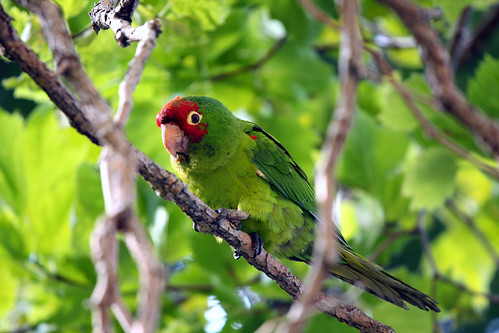 Parrots of Ferry Park (also Telegraph Hill). These are the feral parrots documented in the indi movie The Wild Parrots of Telegraph Hill, by Judy Irving. Image by TorroidAccording to Pliny’s “Natural History,” a raven who hailed the emperor Tiberius every morning became such a local hero that he was granted a funeral procession through the streets of Rome. In September 2007, an African gray parrot named Alex went out in even grander style. Obituaries and articles about the bird appeared in publications around the world, including The New York Times. But even before Alex was found dead in his cage at Brandeis University in Massachusetts, he had made his literary mark with a walk-on part in a novel, “Oryx and Crake,” by Margaret Atwood. Alex thereby joined the venerable, bizarre and surprisingly large club of talking parrots in literature.
Parrots of Ferry Park (also Telegraph Hill). These are the feral parrots documented in the indi movie The Wild Parrots of Telegraph Hill, by Judy Irving. Image by TorroidAccording to Pliny’s “Natural History,” a raven who hailed the emperor Tiberius every morning became such a local hero that he was granted a funeral procession through the streets of Rome. In September 2007, an African gray parrot named Alex went out in even grander style. Obituaries and articles about the bird appeared in publications around the world, including The New York Times. But even before Alex was found dead in his cage at Brandeis University in Massachusetts, he had made his literary mark with a walk-on part in a novel, “Oryx and Crake,” by Margaret Atwood. Alex thereby joined the venerable, bizarre and surprisingly large club of talking parrots in literature.
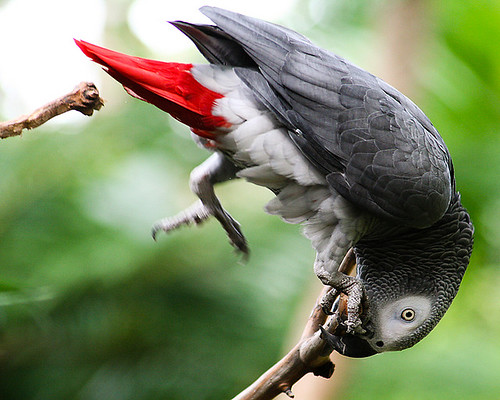 Parrot's a-leaping Afrrican grey Parrot - Blodel Conservatory. Image by Devlon DuthieThe antics of parrots have long been deemed newsworthy, especially in Britain, where the BBC has covered dozens of supposedly true stories about them in the past decade. Almost every such report has been prefigured in a folk tale, novel or poem — even the life and achievements of Alex. “With ladies I learne, and go with them to scole”: thus declaims a parrot in one of the oddest poems in English, “Speke Parrot,” which was written in the early 1520s by Henry VIII’s poet laureate, John Skelton. Alex would have sympathized. He spent three decades being taught by Irene M. Pepperberg and her research assistants, as Pepperberg recounts in her memoir, “Alex and Me,” which will be published later this month.
Parrot's a-leaping Afrrican grey Parrot - Blodel Conservatory. Image by Devlon DuthieThe antics of parrots have long been deemed newsworthy, especially in Britain, where the BBC has covered dozens of supposedly true stories about them in the past decade. Almost every such report has been prefigured in a folk tale, novel or poem — even the life and achievements of Alex. “With ladies I learne, and go with them to scole”: thus declaims a parrot in one of the oddest poems in English, “Speke Parrot,” which was written in the early 1520s by Henry VIII’s poet laureate, John Skelton. Alex would have sympathized. He spent three decades being taught by Irene M. Pepperberg and her research assistants, as Pepperberg recounts in her memoir, “Alex and Me,” which will be published later this month.
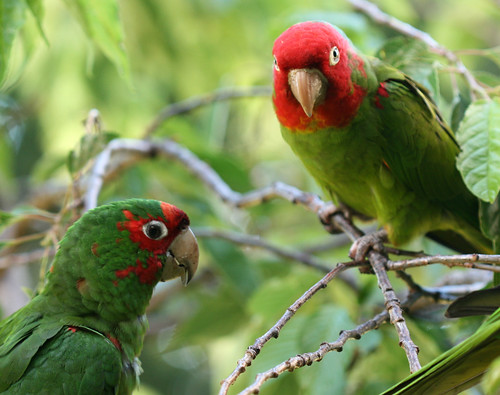 The "parrots of Telegraph Hill" gather in trees in a park in San Francisco, California. Image by Philip BouchardIn 2006, newspapers reveled in the tale of Ziggy, an 8-year-old parrot in Britain who exposed the secret affair that his owner’s girlfriend was conducting with a man called Gary. Ziggy made kissing sounds when the name Gary was spoken on TV and said, “Hiya, Gary,” when the girlfriend’s cellphone rang. She broke down and confessed after Ziggy said, “I love you, Gary,” in an imitation of her voice. The revelation of female infidelity is in fact an ancient staple of parrot literature. In a 13th-century Spanish folk tale, which derives from an earlier Arabic one, a suspicious husband buys a parrot in order to keep an eye on his wife while he is away. Upon returning from his travels, he questions the bird, who reports that the wife was indeed visited by a lover. But she triumphs by tricking the husband into believing that the parrot is a liar, and he has it killed.
The "parrots of Telegraph Hill" gather in trees in a park in San Francisco, California. Image by Philip BouchardIn 2006, newspapers reveled in the tale of Ziggy, an 8-year-old parrot in Britain who exposed the secret affair that his owner’s girlfriend was conducting with a man called Gary. Ziggy made kissing sounds when the name Gary was spoken on TV and said, “Hiya, Gary,” when the girlfriend’s cellphone rang. She broke down and confessed after Ziggy said, “I love you, Gary,” in an imitation of her voice. The revelation of female infidelity is in fact an ancient staple of parrot literature. In a 13th-century Spanish folk tale, which derives from an earlier Arabic one, a suspicious husband buys a parrot in order to keep an eye on his wife while he is away. Upon returning from his travels, he questions the bird, who reports that the wife was indeed visited by a lover. But she triumphs by tricking the husband into believing that the parrot is a liar, and he has it killed.
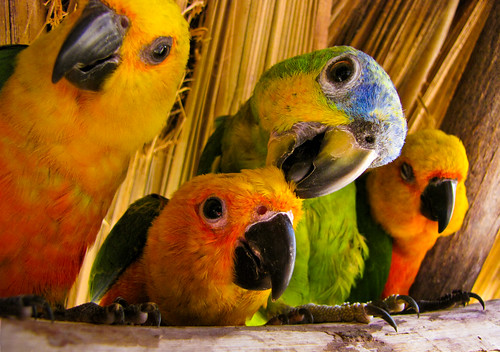 Four Friendly Parrots. Image by Cristiano OliveiraIn a medieval French version of the tale, there are three parrot-spies, only one of which survives, by prudently assuring the wife that he has the wisdom to know when to remain silent. A modern variation on this theme — in a story by Robert Olen Butler, published in The New Yorker in 1995 — has a husband climb a tree to observe his wife in an act of infidelity. He falls to his death and is reincarnated as a parrot, which the wife then purchases from a pet store.
Four Friendly Parrots. Image by Cristiano OliveiraIn a medieval French version of the tale, there are three parrot-spies, only one of which survives, by prudently assuring the wife that he has the wisdom to know when to remain silent. A modern variation on this theme — in a story by Robert Olen Butler, published in The New Yorker in 1995 — has a husband climb a tree to observe his wife in an act of infidelity. He falls to his death and is reincarnated as a parrot, which the wife then purchases from a pet store.
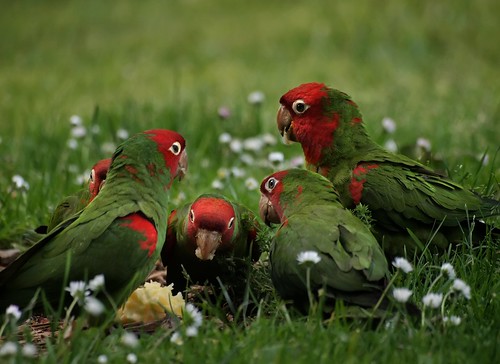 Aratinga erythrogenys - Red-masked Parakeets find a discarded apple core in the grass. Image by Ingrid TaylarBoth in literature and in life, parrots have been employed to bear false witness. In his memoirs, Casanova recounts how he bought one in London’s Smithfield market and trained it to say, “Miss Charpillon is more of a whore than her mother,” in order to exact his revenge on a pair of women who had attempted to swindle him. It was perhaps because of this incident that in 1939, Erle Stanley Gardner gave the name Casanova to the eponymous hero of one of his Perry Mason mysteries, “The Case of the Perjured Parrot.”
Aratinga erythrogenys - Red-masked Parakeets find a discarded apple core in the grass. Image by Ingrid TaylarBoth in literature and in life, parrots have been employed to bear false witness. In his memoirs, Casanova recounts how he bought one in London’s Smithfield market and trained it to say, “Miss Charpillon is more of a whore than her mother,” in order to exact his revenge on a pair of women who had attempted to swindle him. It was perhaps because of this incident that in 1939, Erle Stanley Gardner gave the name Casanova to the eponymous hero of one of his Perry Mason mysteries, “The Case of the Perjured Parrot.”
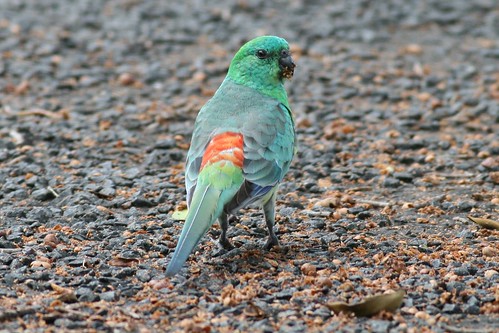 Male Red-rumped Parrot (Psephotus haematonotus) between Wellington and Orange, New South Wales, Australia. Image by Arthur ChapmanGardner’s plot is spectacularly convoluted, though perhaps less strange than the tale of Apsethos the Libyan, which was apparently believed by several historians in classical times. Apsethos taught a flock of caged parrots to say, “Apsethos is a god,” and then released them all over the country in the hope that gullible folk would believe them. This ruse was allegedly foiled by a wily Greek who recaptured some of them and taught them to recite instead, “Apsethos compelled us to say that he is a god.”
Male Red-rumped Parrot (Psephotus haematonotus) between Wellington and Orange, New South Wales, Australia. Image by Arthur ChapmanGardner’s plot is spectacularly convoluted, though perhaps less strange than the tale of Apsethos the Libyan, which was apparently believed by several historians in classical times. Apsethos taught a flock of caged parrots to say, “Apsethos is a god,” and then released them all over the country in the hope that gullible folk would believe them. This ruse was allegedly foiled by a wily Greek who recaptured some of them and taught them to recite instead, “Apsethos compelled us to say that he is a god.”
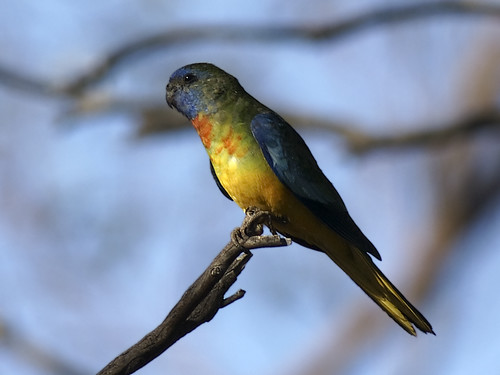 Scarlet-chested Parrot (Neophema splendida) Gluepot Reserve, South Australia, Australia. Immature male. Image by David CookThe most celebrated parrot in 19th-century literature was itself apparently mistaken for God. This is Loulou, in Flaubert’s story “A Simple Heart” — which was partly inspired by a newspaper report of a man driven mad by unrequited love, who lived alone with a parrot that he came to regard as holy. Loulou’s owner, Félicité, is a pious and very unfortunate servant whose only consolation is her adored bird, which she somehow connects with the Holy Spirit. Flaubert describes how, on her deathbed, Félicité seems to see the heavens open to reveal a gigantic Loulou welcoming her up to paradise.
Scarlet-chested Parrot (Neophema splendida) Gluepot Reserve, South Australia, Australia. Immature male. Image by David CookThe most celebrated parrot in 19th-century literature was itself apparently mistaken for God. This is Loulou, in Flaubert’s story “A Simple Heart” — which was partly inspired by a newspaper report of a man driven mad by unrequited love, who lived alone with a parrot that he came to regard as holy. Loulou’s owner, Félicité, is a pious and very unfortunate servant whose only consolation is her adored bird, which she somehow connects with the Holy Spirit. Flaubert describes how, on her deathbed, Félicité seems to see the heavens open to reveal a gigantic Loulou welcoming her up to paradise.
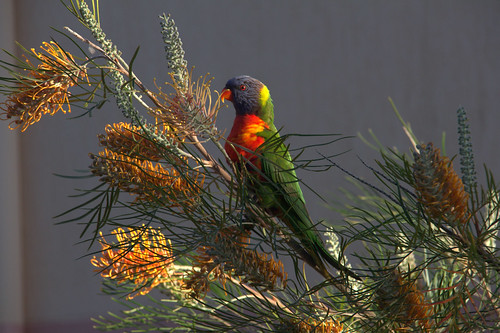 Rainbow Lorikeet, (Trichoglossus haematodus). Image by timAt least since the early Middle Ages, fictional parrots have been credited with unnatural wisdom and sometimes even foresight. An anecdote from the 13th century has the future emperor Charlemagne greeted by prophetic parrots similar to the witches in “Macbeth.” In later medieval European art and literature, parrots are often associated with the Virgin Mary or the Trinity, so it is perhaps not surprising that they seem to be popular with nuns. In a French mock-heroic poem from 1734, a pious parrot named Ver-Vert is the prize possession of a convent in Nevers. On a journey to another convent which wants to borrow him, he is mocked for his prayers and undergoes a personality change, opting for the coarse and ribald persona that is later found in the parrots of Mark Twain, Robert Louis Stevenson, Washington Irving and many other writers, not to mention endless reports from the BBC of embarrassingly obscene birds.
Rainbow Lorikeet, (Trichoglossus haematodus). Image by timAt least since the early Middle Ages, fictional parrots have been credited with unnatural wisdom and sometimes even foresight. An anecdote from the 13th century has the future emperor Charlemagne greeted by prophetic parrots similar to the witches in “Macbeth.” In later medieval European art and literature, parrots are often associated with the Virgin Mary or the Trinity, so it is perhaps not surprising that they seem to be popular with nuns. In a French mock-heroic poem from 1734, a pious parrot named Ver-Vert is the prize possession of a convent in Nevers. On a journey to another convent which wants to borrow him, he is mocked for his prayers and undergoes a personality change, opting for the coarse and ribald persona that is later found in the parrots of Mark Twain, Robert Louis Stevenson, Washington Irving and many other writers, not to mention endless reports from the BBC of embarrassingly obscene birds.
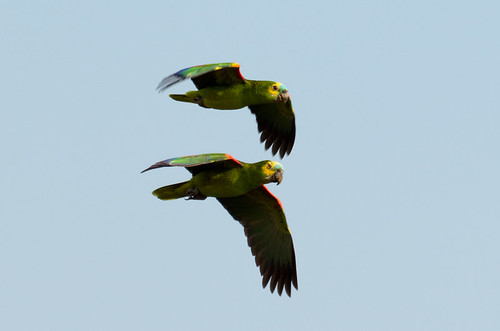 Turquoise-Fronted Amazon Parrot (Amazona aestiva). Image by David SchenfeldSent home in disgrace, Ver-Vert emerges spiritually reborn after months of penance, whereupon the overjoyed nuns of Nevers shower him with candies, and he dies of indigestion. Plus ça change. In “Alex and Me,” Pepperberg quotes a condolence e-mail message sent to her from a priory of Benedictine nuns in Connecticut who have their own beloved parrot. The prioress writes of “these wondrous creatures who have shown us something more of God than we could have ever believed possible.” Perhaps go easy on the candies, ladies.
Turquoise-Fronted Amazon Parrot (Amazona aestiva). Image by David SchenfeldSent home in disgrace, Ver-Vert emerges spiritually reborn after months of penance, whereupon the overjoyed nuns of Nevers shower him with candies, and he dies of indigestion. Plus ça change. In “Alex and Me,” Pepperberg quotes a condolence e-mail message sent to her from a priory of Benedictine nuns in Connecticut who have their own beloved parrot. The prioress writes of “these wondrous creatures who have shown us something more of God than we could have ever believed possible.” Perhaps go easy on the candies, ladies.
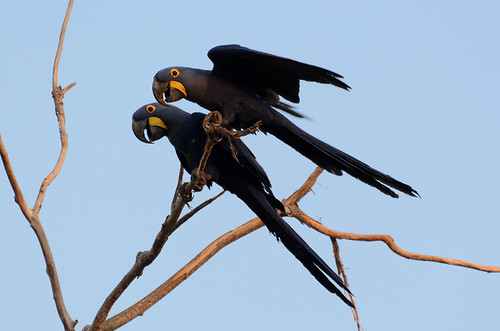 Hyacinth Macaws (Anodorhynchus hyacinthinus) Pantanal Brasil. Image by David SchenfeldFor some reason, death is a leading motif in 20th-century parrot fiction. Monty Python’s dead-parrot sketch is perhaps the most famous instance, but it is far from unique in its absurdity. As Bruce Boehrer notes in his literary study “Parrot Culture” (2004), the novels of Gabriel García Márquez provide a striking brace of examples. In “One Hundred Years of Solitude,” a man kills a parrot and places it in a pot of stew; and in “Love in the Time of Cholera,” a parrot emerges from a pot of stew in order to kill a man. Evelyn Waugh’s “Loved One” memorably records the death of Sambo, a parrot who belonged to the mother of the head undertaker at the Whispering Glades funeral home. And in “Wide Sargasso Sea,” Jean Rhys’s prequel to “Jane Eyre,” the life of Rochester’s first wife is saved by the death of her parrot.
Hyacinth Macaws (Anodorhynchus hyacinthinus) Pantanal Brasil. Image by David SchenfeldFor some reason, death is a leading motif in 20th-century parrot fiction. Monty Python’s dead-parrot sketch is perhaps the most famous instance, but it is far from unique in its absurdity. As Bruce Boehrer notes in his literary study “Parrot Culture” (2004), the novels of Gabriel García Márquez provide a striking brace of examples. In “One Hundred Years of Solitude,” a man kills a parrot and places it in a pot of stew; and in “Love in the Time of Cholera,” a parrot emerges from a pot of stew in order to kill a man. Evelyn Waugh’s “Loved One” memorably records the death of Sambo, a parrot who belonged to the mother of the head undertaker at the Whispering Glades funeral home. And in “Wide Sargasso Sea,” Jean Rhys’s prequel to “Jane Eyre,” the life of Rochester’s first wife is saved by the death of her parrot.
 Three Blue and Yellow Macaws (Ara ararauna) and a nut. Pantanal, Brasil. Image by David SchenfeldLiterary theorists have spun some complex tales of their own about the roles, symbolism and significance of talking parrots in prose and verse. It has been said that the parrots in French literature are always identified with language itself, that they subvert the notion of absolute truth and that they point the way to challenges to the status quo. At least one parrot, though, seemed to tire of the game of literary analysis and turned the tables on his interpreters. In “Zazie in the Metro” (1959), a novel by the playful French philosopher-writer Raymond Queneau, a young girl is accompanied on her adventures through Paris by a parrot called Laverdure. Laverdure responds to all occasions with the same — dare one say parroted? — remark: “Talk talk, that’s all you can do.”
Three Blue and Yellow Macaws (Ara ararauna) and a nut. Pantanal, Brasil. Image by David SchenfeldLiterary theorists have spun some complex tales of their own about the roles, symbolism and significance of talking parrots in prose and verse. It has been said that the parrots in French literature are always identified with language itself, that they subvert the notion of absolute truth and that they point the way to challenges to the status quo. At least one parrot, though, seemed to tire of the game of literary analysis and turned the tables on his interpreters. In “Zazie in the Metro” (1959), a novel by the playful French philosopher-writer Raymond Queneau, a young girl is accompanied on her adventures through Paris by a parrot called Laverdure. Laverdure responds to all occasions with the same — dare one say parroted? — remark: “Talk talk, that’s all you can do.”
 Oddities
Oddities 

